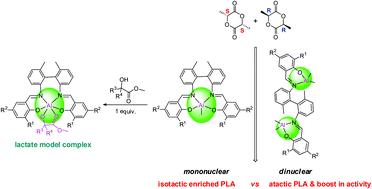Aluminum methyl, alkoxide and α-alkoxy ester complexes supported by 6,6′-dimethylbiphenyl-bridged salen ligands: synthesis, characterization and catalysis for rac-lactide polymerization†
Abstract
The synthesis and characterization of aluminum alkyl and alkoxide complexes bearing racemic 6,6′-dimethylbiphenyl-bridged salen-type ligands, and their catalysis in the ring-opening polymerization (ROP) of rac-lactide are reported. Reactions of AlMe3 with various amounts of the proligands L1−4H2 (6,6′-[(6,6′-dimethyl-[1,1′-biphenyl]-2,2′-diyl)bis(nitrylomethilidyne)]-bis(2-R1-4-R2-phenol): L1H2, R1 = R2 = Me; L2H2, R1 = tBu, R2 = Me; L3H2, R1 = R2 = cumyl; L4H2, R1 = Br, R2 = tBu) afforded the corresponding mono- and dinuclear aluminum methyl complexes [L1−3AlMe (1–3), L1−4Al2Me4 (4–7)]. Aluminum alkoxide complexes L2AlOiPr (8), L2AlOBn (9), and α-alkoxy ester complexes L2Al(OCMe2CO2Me) (10), L2Al[(S)-OCHMeCO2Me] (11) were prepared via in situ alcoholysis of the parent aluminum methyl complex 2 with the corresponding alcohols. The molecular structures of mononuclear complexes 1–3, dinuclear complex 6, alkoxide complexes 8–9 and α-alkoxy ester complexes 10–11 were established by single-crystal X-ray diffraction studies. Two broad resonances at about 69–70 ppm and 25–41 ppm were observed in the 27Al NMR spectra of complexes 10 and 11, indicating the existence of both four- and five-coordinate aluminum centers in solution, which results from the dissociation of one N donor of the salen ligand, accompanied by an association and dissociation equilibrium of the carbonyl group of the α-alkoxy ester ligand to the aluminum center. Complex 11 is also a rare example of an O-lactate model complex that mimics the first insertion of L-LA. All complexes were investigated for the ROP of rac-LA at 110 °C in toluene. The polymerization initiated by complexes 1–3 in the presence of iPrOH showed living features, affording PLAs with narrow molecular weight distributions (PDIs = 1.03–1.05) and 65–73% isotacticities. Particularly, complex 8 showed an “immortal” behavior for the polymerization of rac-LA in the presence of excess alcohol. Compared with the mononuclear counterparts, the tetra-coordinate dinuclear aluminum complexes enabled a few fold boosts in activity, but gave atactic PLAs with broadened PDIs.


 Please wait while we load your content...
Please wait while we load your content...